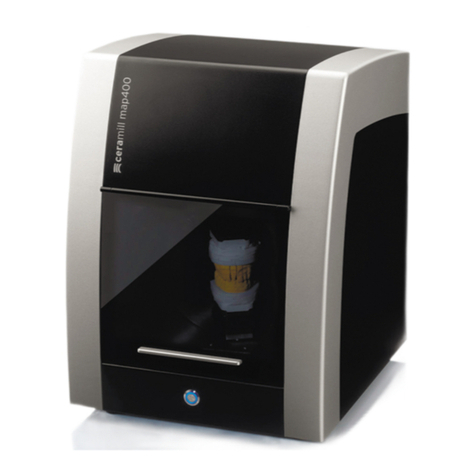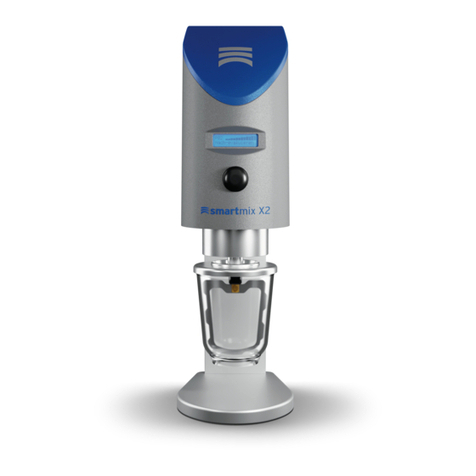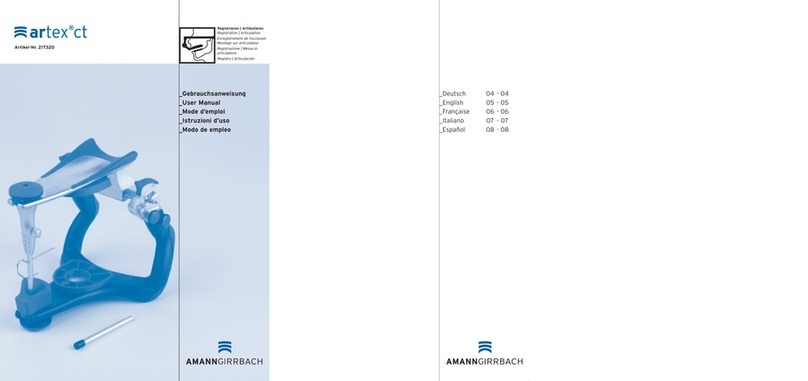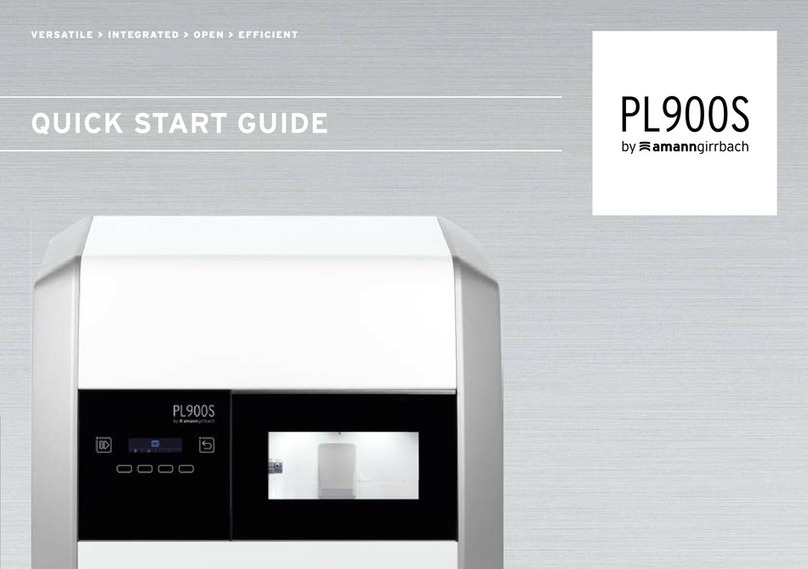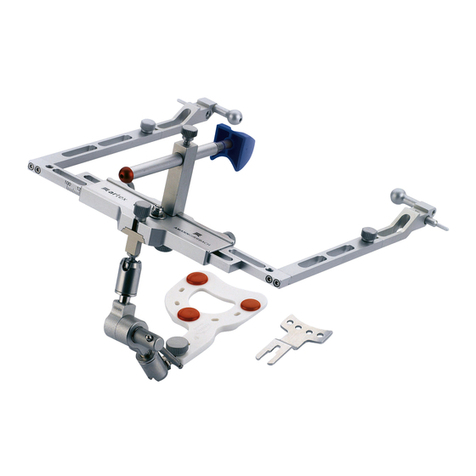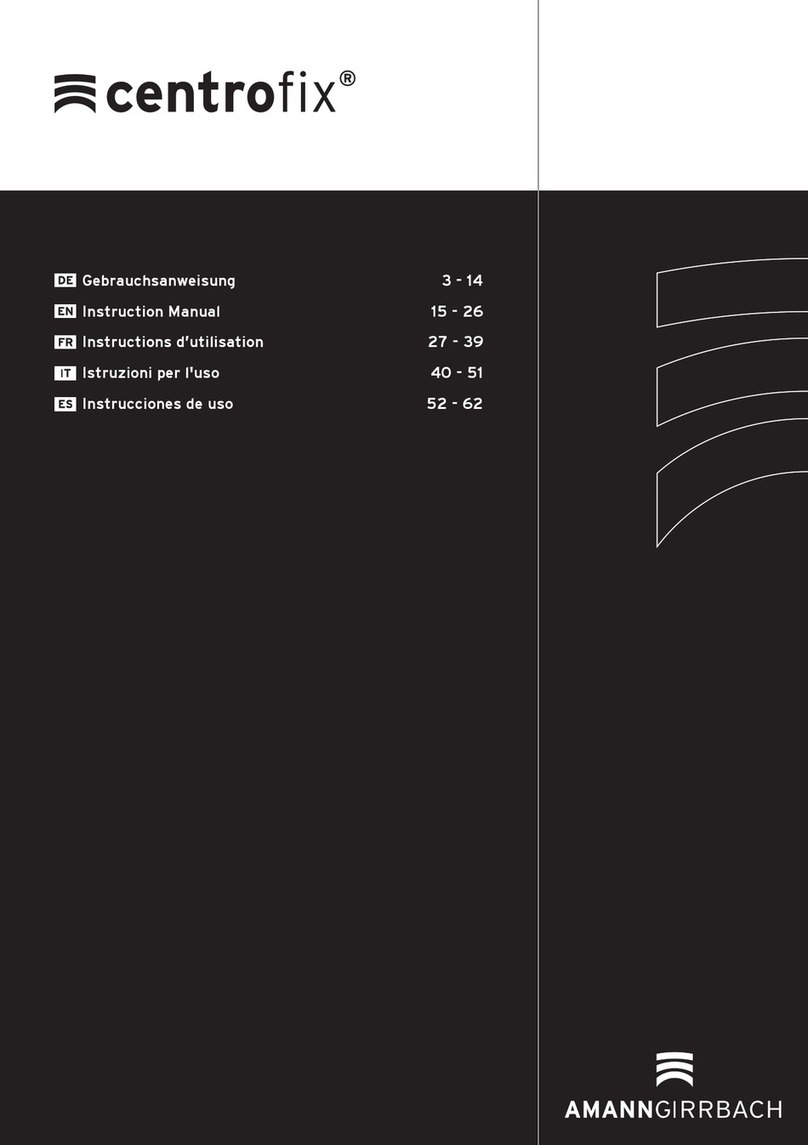
MODE D’EMPLOI MODE D’EMPLOI
FR
8
OUVREZ LA CENTRIQUE
Poussez le levier (2) pivotant vers le haut sur la
butée. Les axes de centrage (2 demis axes) se dépla-
cent vers l‘intérieur et libèrent la centrique.
La centrique est ouverte (3). La pièce condylienne
n‘est plus maintenu de façon fixe. La partie supéri-
eure peut être déplacée librement.
FERMEZ LA CENTRIQUE
Poussez le levier pivotant (4) vers le bas sur la
butée. Les deux demis axes se déplacent vers
l‘extérieur jusqu‘à ce qu‘ils butent légèrement con-
tre l‘axe condylien et arrêtent la partie supérieure
du dispositif Artex en position centrée.
La centrique est fermée (5). Fixation visible de l‘axe
condylien par le demi axe.
RÉGLAGE DE L‘ANGLE DE BENNETT
Ouvrez la trajectoire/la centrique (6). Desserrez la
vis de verrouillage de l‘angle de Bennett à l‘aide de
la clé d‘alêne. Le bouton rotatif permet de régler
l‘élément condylien de -5° à +30°.
Illustration : Angle de Bennett = 0°.
A l‘aide du bouton (7) rotatif, tournez l‘angle de
Bennett sur la valeur d‘échelle souhaitée et fixez-la
à l‘aide de la clé d‘alêne.
Illustration : Angle de Bennett = 30°
RÉGLAGE DE L‘INCLINAISON DE LA TRAJEC-
TOIRE CONDYLIENNE
Desserrez la vis de verrouillage I.T.C (8) à l‘aide
de la clé d‘alêne. Sélectionnez l‘angle souhaité en
tournant le boîtier condylien. Fixez ensuite la vis de
verrouillage I.T.C à l‘aide de la clé d‘alêne.
Possibilité de réglage I.T.C. (9) de -20° à +60°. On
peut lire l‘angle d‘inclinaison sur le bord antérieur
de la partie postérieure (il est mis en concordance
avec l‘échelle).
Illustration: I.TC = +60°
DÉROULEMENT DU MOUVEMENT
Pièce condylienne en position centrée et en mou-
vement avec des angles de Bennett différents (vue
plongeante sur les condyles)
ATTENTION
Les mouvements dans les articulateurs Arcon
doivent se dérouler avec contact permanent
des pièces condyliennes (partie inférieure de
l‘articulateur) avec le boîtier condylien (partie supé-
rieure de l‘articulateur). Ils ne seront reproductibles
que de cette manière.
(10) Angle de Bennett réglé sur 0°.
Pièce condylienne en position centrée = position de
départ pour le déroulement du mouvement.
(11) Angle de Bennett sur 0°.
La pièce condylienne est guidée, en contact perma-
nent de l‘élément condylien, dans les 3 niveaux de
l‘espace. La pièce condylienne ne doit en aucune
phase du mouvement perdre le contact avec la
fosse, ni en direction du crâne, ni en direction des
maxillaires.
(12) Angle de Bennett réglé sur 30°.
Pièce condylienne en position centrée = position de
départ pour le déroulement du mouvement.
(13) Angle de Bennett réglé sur 30°.
La pièce condylienne est guidée, en contact perma-
nent avec le boîtier condylien, dans les 3 niveaux de
l‘espace.
TIGE ARBITRAIRE/CENTRE DE L‘AXE
Le transfert du maxillaire supérieur, orienté (14) en
fonction de l‘axe crânien, peut s‘effectuer directe-
ment sur l‘articulateur par adaptation de l‘arc facial.
Pour ce faire on pourra utiliser aussi bien la tige
arbitraire elle reproduit la position de la capsule au-
riculaire et/ou la cavité des boutons poreux à titre
de référence.
